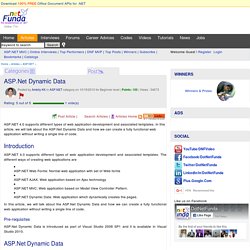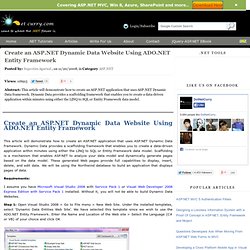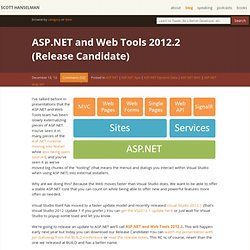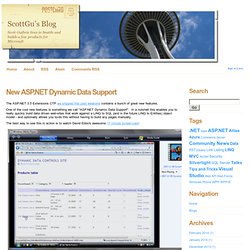

ASP.Net Dynamic Data. ASP.NET 4.0 supports different types of web application development and associated templates.

In this article, we will talk about the ASP.Net Dynamic Data and how we can create a fully functional web application without writing a single line of code. Introduction ASP.NET 4.0 supports different types of web application development and associated templates. The different ways of creating web applications are ASP.NET Web Forms: Normal web application with set of Web forms ASP.NET AJAX: Web application based on Ajax technology ASP.NET MVC: Web application based on Model View Controller Pattern. In this article, we will talk about the ASP.Net Dynamic Data and how we can create a fully functional web application without writing a single line of code.
Pre-requisites. Create an ASP.NET Dynamic Data Website Using ADO.NET Entity Framework. Create an ASP.NET Dynamic Data Website Using ADO.NET Entity Framework This article will demonstrate how to create an ASP.NET application that uses ASP.NET Dynamic Data framework.

Dynamic Data provides a scaffolding framework that enables you to create a data-driven application within minutes using either the LINQ to SQL or Entity Framework data model. Scaffolding is a mechanism that enables ASP.NET to analyze your data model and dynamically generate pages based on the data model. These generated Web pages provide full capabilities to display, insert, delete, and edit data. We will be using the Northwind database to build an application that displays pages of data. Requirements: Step 1: Open Visual Studio 2008 > Go to File menu > New Web Site.
The structure of the application in the Solution Explorer will look similar to the following: Step 2: The next step is to add a data source to the project. Note: If you are using SQL Express, follow these steps. Scott Hanselman - ASP.NET Dynamic Data. Do you like a big pile of source code?

Well, there is an imperial buttload of source in the Visual Studio 2010 and .NET Framework 4 Training Kit. It's actually a 178 meg download, which is insane. Perhaps start your download now and get it in the morning when you get up. It's extremely well put together and I say Kudos to the folks that did it. They are better people than I. I like to explore it while watching TV myself and found myself looking through tonight. Here's an outline of what's inside. I love using this kit in my talks, and used it a lot in my Lap Around .NET 4 talk. There's Labs, Presentations, Demos, Labs and links to online Videos. Here's a few of my favorite bits, and they aren't the parts you hear the marketing folks gabbing about.
Code Contracts Remember the old coding adage to "Assert Your Expectations? " Code Contracts continues to be revised, with a new version out just last month for both 2008 and 2010. Here's a basic idea of what it looks like. Parallel Extensions. New ASP.NET Dynamic Data Support. The ASP.NET 3.5 Extensions CTP we shipped this past weekend contains a bunch of great new features.

One of the cool new features is something we call "ASP.NET Dynamic Data Support". In a nutshell this enables you to really quickly build data driven web-sites that work against a LINQ to SQL (and in the future LINQ to Entities) object model - and optionally allows you to-do this without having to build any pages manually. The best way to see this in action is to watch David Ebbo's awesome 17 minute screen-cast: You can also follow the steps below to easily get started and use the dynamic data support: Step 1: Create a ASP.NET Dynamic Data Site: Once you have the ASP.NET 3.5 Extensions CTP release installed, you can use VS 2008 or the free Visual Web Developer 2008 Express to create a new Web Site or Web Application Project that has the ASP.NET dynamic data support enabled: Step 2: Add a LINQ to SQL Data Model to Your Site Step 3: Enable Dynamic Templates in Your Project: Step 4: Run Your Site.
Dynamic Data: The Official Microsoft ASP.NET Site.